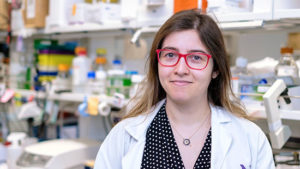
Northwestern Medicine scientists have identified critical regulatory processes that govern differentiation in embryonic stem cells, according to a study published in the Proceedings of the National Academy of the Sciences (PNAS).

“The Set1A complex is required for survival of embryonic stem cells, and now we know why,” said Bercin Cenik, MD, PhD, postdoctoral fellow in the Shilatifard laboratory and lead author of the study.
Ali Shilatifard, PhD, the Robert Francis Furchgott Professor, chair of Biochemistry and Molecular Genetics, a professor of Pediatrics, director of the Simpson Querrey Institute for Epigenetics and a member of the Robert H. Lurie Comprehensive Cancer Center of Northwestern University, was senior author of the study.
The COMPASS complex of proteins associated with Set1 (COMPASS) family is critical for epigenetic gene regulation — the process of expressing certain genes at specific times. COMPASS methylates histones, the proteins around which DNA is packaged, a process that controls which genes are available for transcription and eventual expression.

Set1A is one member of the COMPASS family, but previous studies in the Shilatifard laboratory had shown it was particularly important for embryonic stem cells. Cells that lacked other members of the COMPASS family had minor issues, but stem cells lacking Set1A did not survive at all.
In the current study, investigators performed a genome-wide screen using CRISPR-Cas9 gene editing, individually deleting every gene in the mammalian genome from pairs of embryonic stem cells — one normal cell line and one with Set1A’s enzymatic activity removed.
One gene called ING5 — that codes for the same protein — was the top hit, showing significantly reduced cell survival when deleted in Set1A-mutant cells. Interestingly, the simultaneous loss of Set1A and ING5 produced a different effect than losing either alone, according to Cenik.
“You see upregulation of some differentiation-associated genes, but only in regions that are occupied by both proteins” Cenik said. “This points to them acting as genetic interactors, functioning together on chromatin.”
Revealing the downstream interactors of Set1A is critical for learning how defects in embryonic stem cells can contribute to diseases, especially in neurodevelopmental diseases such as epilepsy and schizophrenia. In the future, Cenik said she hopes to test the ability of Set1A-negative stem cells to differentiate into neurons or cardiac cells, with the hopes of discovering a phenotype that may resemble disease seen in patients.
“We’ve seen some neurodevelopmental disease-like findings, so taking these cells and differentiating them into neurons would be one way to elucidate that link,” Cenik said.
This study was supported by National Institutes of Health grant R35CA197569.






